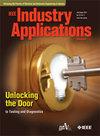一种故障条件下输电线路结构附近概率安全风险评估新方法
IF 4.2
2区 工程技术
Q2 ENGINEERING, ELECTRICAL & ELECTRONIC
引用次数: 0
摘要
输电线路与城市地区的距离越来越近,由于输电线路故障时潜在的接触和阶跃电压危险,引起了人们对安全问题的关注。许多地区缺乏全面的安全标准使情况变得更糟。尽管已经尝试了确定性和概率风险评估方法来解决这个问题,但概率风险评估方法引起了更多的关注,因为它允许电力公司在有限的运营预算下量化和优先考虑风险位置,通过风险评分首先降低概率最高的位置的公共风险。然而,目前概率风险评估方法的参数都是基于假设的,这大大降低了风险评估的准确性。在本文中,提出了新的有效的方法来准确地确定这些参数,包括故障概率、人类存在的概率和心室颤动的概率。本文为电力公司和监管机构提供了一个准确的概率风险评估工具,以主动评估和减轻输电线路结构附近的安全风险,并确保日益城市化景观中的公众安全。本文章由计算机程序翻译,如有差异,请以英文原文为准。
A Novel Probabilistic Safety Risk Assessment Approach Near Transmission Line Structures Under Fault Conditions
The increasing proximity of transmission lines to urban areas has raised safety concerns due to potential touch and step voltage hazards during transmission line faults. Lacking of a comprehensive safety standard in many regions makes the situation worse. Although both deterministic and probabilistic risk assessment approaches have been attempted for this issue, the probabilistic risk assessment approach has attracted more attention, as it allows electric utilities with a limited operational budget to quantify and prioritize risk locations by mitigating the public risk for a location with the highest probability first through a risk score. However, the parameters of the probabilistic risk assessment approach are currently based on assumptions, which significantly reduces the risk assessment accuracy. In this paper, new effective methods are proposed to accurately determine these parameters, including the probability of faults, the probability of human presence, and the probability of ventricular fibrillation. This paper offers an accurate probabilistic risk assessment tool for electric utilities and regulatory bodies to proactively assess and mitigate safety risks near transmission line structures and ensure the public's safety in an increasingly urbanized landscape.
求助全文
通过发布文献求助,成功后即可免费获取论文全文。
去求助
来源期刊

IEEE Transactions on Industry Applications
工程技术-工程:电子与电气
CiteScore
9.90
自引率
9.10%
发文量
747
审稿时长
3.3 months
期刊介绍:
The scope of the IEEE Transactions on Industry Applications includes all scope items of the IEEE Industry Applications Society, that is, the advancement of the theory and practice of electrical and electronic engineering in the development, design, manufacture, and application of electrical systems, apparatus, devices, and controls to the processes and equipment of industry and commerce; the promotion of safe, reliable, and economic installations; industry leadership in energy conservation and environmental, health, and safety issues; the creation of voluntary engineering standards and recommended practices; and the professional development of its membership.
 求助内容:
求助内容: 应助结果提醒方式:
应助结果提醒方式:


